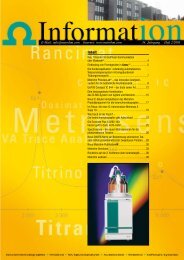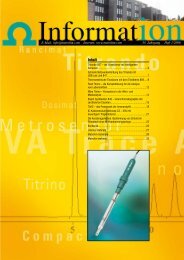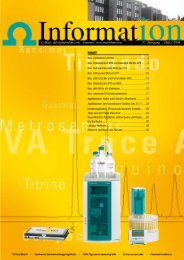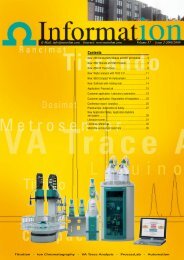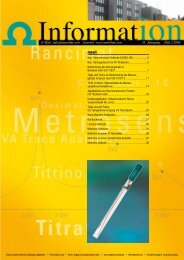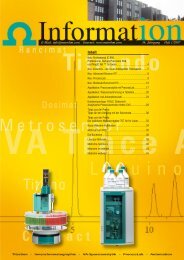What is the theoretical background of potentiometry? - Metrohm
What is the theoretical background of potentiometry? - Metrohm
What is the theoretical background of potentiometry? - Metrohm
You also want an ePaper? Increase the reach of your titles
YUMPU automatically turns print PDFs into web optimized ePapers that Google loves.
1. BASICS OF POTENTIOMETRY• Can physical parameters such as flow, pressure ortemperature cause measuring errors?• Does <strong>the</strong> process allow cleaning/maintenance <strong>of</strong><strong>the</strong> electrode at certain intervals?• Is a short response time and/or high reproducibilitynecessary?The time required for cleaning and maintenance canusually be considerably reduced if <strong>the</strong> correct choice<strong>of</strong> electrode <strong>is</strong> made. The most frequent cause <strong>of</strong>measuring problems <strong>is</strong> contamination <strong>of</strong> <strong>the</strong> diaphragm.Th<strong>is</strong> <strong>is</strong> why with pH electrodes <strong>the</strong> chief attention<strong>is</strong> paid to <strong>the</strong> diaphragm during maintenancewith <strong>the</strong> pH membrane being <strong>of</strong> secondary importance.Each unnecessary etching process accelerates<strong>the</strong> aging <strong>of</strong> <strong>the</strong> pH electrode. If ex<strong>is</strong>ting means cannotbe used to determine whe<strong>the</strong>r <strong>the</strong> indicator electrodeor <strong>the</strong> reference electrode requires cleaning/regeneration, <strong>the</strong>n it <strong>is</strong> usually best to treat <strong>the</strong>reference electrode. Various types <strong>of</strong> diaphragm areavailable to sat<strong>is</strong>fy <strong>the</strong> diverse requirements. These requirementshave already been taken into considerationfor <strong>the</strong> electrode recommendations in <strong>the</strong> applicationl<strong>is</strong>ts on pages 6 and 7.remain negligibly small. These properties are particularlyimportant for a SET titration to a defined pHor potential value. For example: <strong>the</strong> determination <strong>of</strong><strong>the</strong> carbonate alkalinity by a SET titration to pH = 5.4according to ISO 9963-2 <strong>is</strong> a widely used method in<strong>the</strong> routine analys<strong>is</strong> <strong>of</strong> drinking water. During a titrationit <strong>is</strong> not possible to d<strong>is</strong>pense with stirring, i.e.with an incorrectly measured pH or potential at <strong>the</strong>start <strong>of</strong> <strong>the</strong> titration an incorrect endpoint <strong>is</strong> <strong>the</strong> inevitableresult. Figures 11 and 12 clearly show <strong>the</strong> differencebetween <strong>the</strong> Aquatrode Plus (6.0253.100),which was specially developed for th<strong>is</strong> application,and a conventional pH glass electrode with ceramicpin diaphragm.Ceramic pin diaphragmsCeramic pin diaphragms are <strong>the</strong> most frequently useddiaphragms. They are primarily suitable for clear,aqueous sample solutions. They normally have porediameters <strong>of</strong> up to 1 μm with a length and diametereach <strong>of</strong> about 1 mm. Th<strong>is</strong> results in an electrolyteflow rate <strong>of</strong> up to 25 μL/h, depending on <strong>the</strong> condition<strong>of</strong> <strong>the</strong> diaphragm. Th<strong>is</strong> means that <strong>the</strong> referenceelectrolyte only requires refilling at long intervals; th<strong>is</strong><strong>is</strong> why electrodes with ceramic pin diaphragms areparticularly suitable for long-term measurements. On<strong>the</strong> o<strong>the</strong>r hand, because <strong>of</strong> <strong>the</strong>ir small pores andlarge polar surface (>>500 mm 2 ), ceramic diaphragmstend to become blocked and <strong>the</strong>refore should not beused in solutions containing precipitates. An importantadvance with regard to <strong>the</strong> prevention <strong>of</strong> diaphragmblockages by silver chloride and silver sulfidehas been achieved by <strong>the</strong> introduction <strong>of</strong> <strong>the</strong> «LongLife» reference system (see Section «The Metrosensor’Long Life’ reference system»).Ground-joint diaphragms with fixed orseparable ground jointGround-joint diaphragms with fixed or separableground joint are used in ion-deficient media, amongo<strong>the</strong>rs, as <strong>the</strong>y produce a steady signal that <strong>is</strong> almostindependent <strong>of</strong> sample flow conditions. The r<strong>is</strong>k <strong>of</strong>blockage by silver chloride or by precipitates formedin <strong>the</strong> sample solution <strong>is</strong> relatively low because <strong>of</strong> <strong>the</strong>large surface area. Streaming potentials, which mayoccur in measurements in flowing or stirred solutions,Figure 11:Measured pH <strong>of</strong> a solution with c(Na 2 CO 3 ) = 0.14 mmol/L. Evenunder vigorous stirring <strong>the</strong> Aquatrode Plus deviates by only approx.0.05 pH units (corresponding to approx. 3 mV) from <strong>the</strong> unstirredvalue, in contrast <strong>the</strong> pH glass electrode with ceramic pin diaphragmdeviates by approx. 0.2 pH units.Figure 12:Endpoint volumes <strong>of</strong> a SET titration <strong>of</strong> a solution with c(Na 2 CO 3 ) =0.14 mmol/L with <strong>the</strong> titrant c(H 2 SO 4 ) = 0.035 mol/L to pH 5.4. Theendpoints <strong>of</strong> <strong>the</strong> Aquatrode Plus are virtually independent<strong>of</strong> <strong>the</strong> stirring speed. At higher stirring speeds <strong>the</strong> deviation from<strong>the</strong> <strong>the</strong>oretical value <strong>of</strong> <strong>the</strong> pH electrode with ceramic diaphragmamounts to approx. 5%.86




